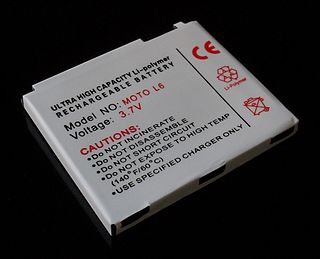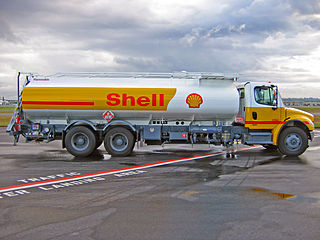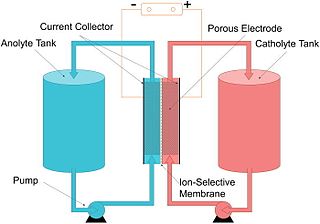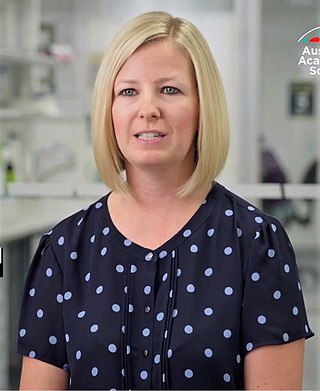Related Research Articles
Kerosene, or paraffin, is a combustible hydrocarbon liquid which is derived from petroleum. It is widely used as a fuel in aviation as well as households. Its name derives from κηρός (kērós) meaning "wax", and was registered as a trademark by Nova Scotia geologist and inventor Abraham Gesner in 1854 before evolving into a generic trademark. It is sometimes spelled kerosine in scientific and industrial usage.
An electrolyte is a substance that conducts electricity through the movement of ions, but not through the movement of electrons. This includes most soluble salts, acids, and bases, dissolved in a polar solvent like water. Upon dissolving, the substance separates into cations and anions, which disperse uniformly throughout the solvent. Solid-state electrolytes also exist. In medicine and sometimes in chemistry, the term electrolyte refers to the substance that is dissolved.

A lithium polymer battery, or more correctly, lithium-ion polymer battery, is a rechargeable battery of lithium-ion technology using a polymer electrolyte instead of a liquid electrolyte. Highly conductive semisolid (gel) polymers form this electrolyte. These batteries provide higher specific energy than other lithium battery types. They are used in applications where weight is critical, such as mobile devices, radio-controlled aircraft, and some electric vehicles.

Aviation fuels are petroleum-based fuels, or petroleum and synthetic fuel blends, used to power aircraft. They have more stringent requirements than fuels used for ground use, such as heating and road transport, and contain additives to enhance or maintain properties important to fuel performance or handling. They are kerosene-based for gas turbine-powered aircraft. Piston-engined aircraft use leaded gasoline and those with diesel engines may use jet fuel (kerosene). By 2012, all aircraft operated by the U.S. Air Force had been certified to use a 50-50 blend of kerosene and synthetic fuel derived from coal or natural gas as a way of stabilizing the cost of fuel.

Jet fuel or aviation turbine fuel is a type of aviation fuel designed for use in aircraft powered by gas-turbine engines. It is colorless to straw-colored in appearance. The most commonly used fuels for commercial aviation are Jet A and Jet A-1, which are produced to a standardized international specification. The only other jet fuel commonly used in civilian turbine-engine powered aviation is Jet B, which is used for its enhanced cold-weather performance.

Potassium peroxymonosulfate is widely used as an oxidizing agent, for example, in pools and spas. It is the potassium salt of peroxymonosulfuric acid. Potassium peroxymonosulfate per se is rarely encountered. It is often confused with the triple salt 2KHSO5·KHSO4·K2SO4, known as Oxone.

A flow battery, or redox flow battery, is a type of electrochemical cell where chemical energy is provided by two chemical components dissolved in liquids that are pumped through the system on separate sides of a membrane. Ion transfer inside the cell occurs across the membrane while the liquids circulate in their respective spaces.

An electric spark is an abrupt electrical discharge that occurs when a sufficiently high electric field creates an ionized, electrically conductive channel through a normally-insulating medium, often air or other gases or gas mixtures. Michael Faraday described this phenomenon as "the beautiful flash of light attending the discharge of common electricity".

Iridium(IV) oxide, IrO2, is the only well-characterised oxide of iridium. It is a blue-black solid. The compound adopts the TiO2 rutile structure, featuring six coordinate iridium and three coordinate oxygen.

An aviation biofuel is a biofuel used to power aircraft and is a sustainable aviation fuel (SAF). The International Air Transport Association (IATA) considers it a key element in reducing the environmental impact of aviation. Aviation biofuel is used to decarbonize medium and long-haul air travel. These types of travel generate the most emissions, and could extend the life of older aircraft types by lowering their carbon footprint. Synthetic paraffinic kerosene (SPK) refers to any non-petroleum-based fuel designed to replace kerosene jet fuel, which is often, but not always, made from biomass.
Photoelectrochemical reduction of carbon dioxide, also known as photoelectrolysis of carbon dioxide, is a chemical process whereby carbon dioxide is reduced to carbon monoxide or hydrocarbons by the energy of incident light. This process requires catalysts, most of which are semiconducting materials. The feasibility of this chemical reaction was first theorised by Giacomo Luigi Ciamician, an Italian photochemist. Already in 1912 he stated that "[b]y using suitable catalyzers, it should be possible to transform the mixture of water and carbon dioxide into oxygen and methane, or to cause other endo-energetic processes."
Methylpyridinium is an ion with the formula C5H5NCH+3. It is the N-methylated derivative of pyridine. It confers no color to its salts. The ion is classified as an quaternary ammonium ion.

A solid dispersion redox flow battery is a type of redox flow battery using dispersed solid active materials as the energy storage media. The solid suspensions are stored in energy storage tanks and pumped through electrochemical cells while charging or discharging. In comparison with a conventional redox flow battery where active species are dissolved in aqueous or organic electrolyte, the active materials in a solid dispersion redox flow battery maintain the solid form and are suspended in the electrolyte. Further development expanded the applicable active materials. The solid active materials, especially with active materials from lithium-ion battery, can help the suspensions achieve much higher energy densities than conventional redox flow batteries. This concept is similar to semi-solid flow batteries in which slurries of active materials accompanied by conductive carbon additives to facilitate electrons conducting are stored in energy storage tanks and pumped through the electrochemical reaction cells. Based upon this technique, an analytical method was developed to measure the electrochemical performance of lithium-ion battery active materials, named dispersed particle resistance (DPR).

Doron Aurbach is an Israeli electrochemist, materials and surface scientist.
Scanning vibrating electrode technique (SVET), also known as vibrating probe within the field of biology, is a scanning probe microscopy (SPM) technique which visualizes electrochemical processes at a sample. It was originally introduced in 1974 by Jaffe and Nuccitelli to investigate the electrical current densities near living cells. Starting in the 1980s Hugh Isaacs began to apply SVET to a number of different corrosion studies. SVET measures local current density distributions in the solution above the sample of interest, to map electrochemical processes in situ as they occur. It utilizes a probe, vibrating perpendicular to the sample of interest, to enhance the measured signal. It is related to scanning ion-selective electrode technique (SIET), which can be used with SVET in corrosion studies, and scanning reference electrode technique (SRET), which is a precursor to SVET.
Shelley D. Minteer is an American academic and chemistry professor at the University of Utah. Minteer field of study focuses on the interface between biocatalysts and enzyme-based electrodes for biofuel cells and sensors.

Electrochemical quartz crystal microbalance (EQCM) is the combination of electrochemistry and quartz crystal microbalance, which was generated in the eighties. Typically, an EQCM device contains an electrochemical cells part and a QCM part. Two electrodes on both sides of the quartz crystal serve two purposes. Firstly, an alternating electric field is generated between the two electrodes for making up the oscillator. Secondly, the electrode contacting electrolyte is used as a working electrode (WE), together with a counter electrode (CE) and a reference electrode (RE), in the potentiostatic circuit constituting the electrochemistry cell. Thus, the working electrode of electrochemistry cell is the sensor of QCM.

Cao Chunan was a Chinese scientist who specialized in corrosion and electrochemistry. He was a member of the Jiusan Society.

Debbie Sue Silvester-Dean is a British-Australian chemist who is a professor at Curtin University. Her research considers electrochemical processes and sensing. She has explored room-temperature ionic liquids. In 2021, she was awarded the Australian Academy of Science Le Fèvre Medal.

Maria de Fátima Montemor is a Portuguese researcher known for her work in coatings for surface protection and functionality, and materials for electrodes for electrochemical energy storage devices. She is a full professor at Instituto Superior Técnico.
References
- 1 2 3 4 "Networks and Volunteers Working Group". Alumni. Retrieved 31 May 2018.
- ↑ "Splendid Bowling Competition". Tattenhall Online. Retrieved 31 May 2018.
- ↑ Bauldreay, J.M.; Archer, M.D. (1 November 1983). "Dye-modified electrodes for photogalvanic cells". Electrochimica Acta. 28 (11): 1515–1522. doi:10.1016/0013-4686(83)85210-4. ISSN 0013-4686.
- ↑ Bauldreay, J.M.; Archer, M.D. (1 October 1985). "Mediated redox reactions at the 1-aminophenazine-modified rotating disc electrode". Electrochimica Acta. 30 (10): 1355–1359. doi:10.1016/0013-4686(85)85014-3. ISSN 0013-4686.
- ↑ "SOLAR-JET - Partners". www.solar-jet.aero. Archived from the original on 20 June 2018. Retrieved 31 May 2018.
- ↑ "AIAA To Host "Inside Aerospace" - An International Forum For Aerospace Leaders On Energy And Environmental Challenges". www.aerospaceonline.com. Retrieved 31 May 2018.
- ↑ Liquid fuel compositions, 28 April 2010, retrieved 31 May 2018
- ↑ Kerosene base fuel, 17 March 2009, retrieved 31 May 2018
- ↑ Methods of providing higher quality liquid kerosene based-propulsion fuels, 21 December 2016, retrieved 31 May 2018
- ↑ Process for the preparation of middle distillates from kerogen, 17 March 2008, retrieved 31 May 2018
- ↑ Bauldreay, Joanna (8 October 2012). "Alternative Fuels - Alternatives and Production" (PDF). Air Transport Net. Retrieved 31 May 2018.
- ↑ Admin, MemberClicks. "The IASH Lifetime Achievement Award". www.iash.net. Retrieved 31 May 2018.